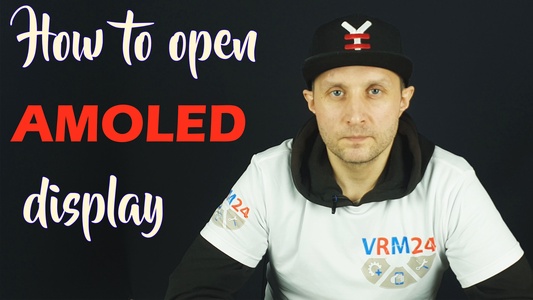
Hi, guys! Name is Vadim. We are on the vrm24.com and today we will consider one of the ways to open the smartphone's display module with an AMOLED display type. Please note, this text cannot be guided for smartphones with IPS and TFT displays!
So, let's get started!

For example, we will use a smartphone, Samsung Galaxy A6 Plus (2018). We will heat it on a heating mat. We will spray isopropyl alcohol for separation. I want to note that it is strictly forbidden to use isopropyl alcohol in models with IPS and TFT displays - otherwise, the display may be damaged. Also we will use several thin plastic sheets/films. In our case we have plastic protective films from new displays for separation). Moreover, screwdriver Philips cross-head 1.5 mm #000 to unscrew one screw securing display connector and any non-metal or plastic tool to disconnect the connector.

On this model, the module is glued to the frame, so this video will generally fit most models with an AMOLED display type. But there is always should be BUT! Look at the locations of the cables and connectors. Find out where the display module is glued. By the way, why is it called the module? Because it is an assembly of the front glass, touchscreen, and display.

To understand the cable's location, open our website. Look at which step is about the display module and see where the cable and connector. So it may be that your model is not represented on our website - choose another website or watch the video on any video platform.
Okay, we see the cable location and approximately understand where the display is glued. Let's start work.

We need to put a tool between the module and the plastic frame. In our case, we use plastic film. To do this, we should heat the display surface to soften the adhesive base. Therefore, we heat the display surface up to 70°C or 158-degree Fahrenheit and try to push the plastic sheet through. As always, our weak point is the corners. It is safer to choose a far corner from the cable location.
We can heat the surface of the display, and we will... many times... soften the adhesive. We heat up and try to push the tool in, heat up, try to hook, and so on. Why so? Because displays are fragile, sometimes pretty fragile, so you need to work carefully, carefully so as not to damage anything. Also, we will not heat too much so as not to melt the frame to which the display is glued.

If! The adhesive base still firmly holds the display module. Return the smartphone to the heating surface or warm up with a heat gun for a couple more minutes and continue to try to push through.
Be careful. We are primarily responsible for the repair. If somewhere something does not move - there is no need to try to act by force. It is better to look for information on this topic - watch a video, read on forums or thematic websites.

So here is the sequence of work we have: we heat the surface of the display. We try to push the plastic in, we heat - we try, we heat, we try, we heat, we try - we finally pick it up and begin to pass along the edge with a plastic tool.

While we are not trying to work at the cable's location and move through the plastic film along the free edges, carefully spray isopropyl alcohol, which penetrates into the gap and dries the adhesive base.

At some point, you can use such a technique, which I would call a two-man saw. But only in the place where there is no cable! Otherwise, we can break the cable. If you have no experience, it is better not to do this, but carefully move the film along the edges.
And when we passed all sides except the bottom. We move to the lower part in a place where the cable is wider and is located as close as possible to the edge. It is critical not to rush, slowly, but surely - this is our motto in this case, and for any repair, too. Do not be afraid if the separation takes up to 20 minutes.

And as soon as we felt that we can open it, we carefully look inside through the gap, notice the cable and connector's location, chose the angle, and open the display module.


Then gently lay the display on a flat surface so that the cable does not stretch. Take a Phillips screwdriver cross-head 1.5 mm, and unscrew the screw securing the connector. After that, we need to remove the bracket and disconnect the connector. It is better to use a non-metal or plastic tool because the smartphone is still powered.

Well, now we have opened the display module, the job's done - watch our videos, read articles and guides and please - take care of yourself…
If you have a question, ask us, and we will try to answer in as much detail as possible. If this article was helpful for you, please rate it.
